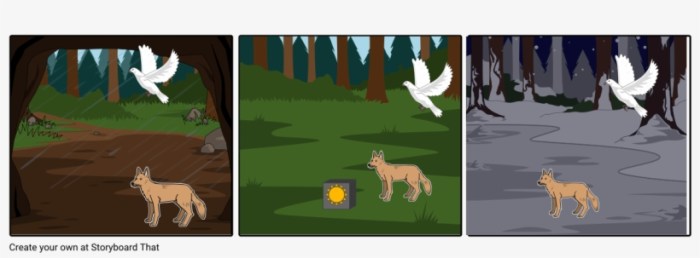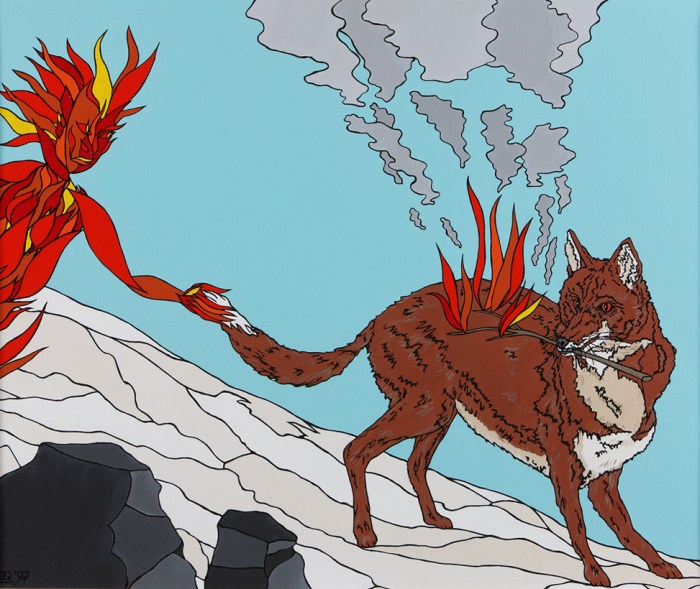In the realm of Native American folklore, “Coyote Steals the Sun and Moon” stands as a captivating creation myth that has shaped tribal beliefs and traditions for centuries. This tale of a cunning trickster and the celestial bodies he captures unfolds with a rich tapestry of cultural significance, literary artistry, and artistic interpretations.
The coyote, a revered and enigmatic figure in Native American mythology, emerges as the central protagonist in this timeless narrative. His cunning and mischievous nature drives the plot as he embarks on a daring quest to bring light to a world shrouded in darkness.
Cultural Significance

The “Coyote Steals the Sun and Moon” story is deeply embedded in Native American folklore, holding immense cultural significance for various tribes across North America. The tale symbolizes the triumph of light over darkness, the balance between celestial bodies, and the origins of day and night.
Variations and Similarities
While the core elements of the story remain consistent, variations exist among different tribes. In many versions, Coyote is portrayed as a mischievous and cunning trickster figure who steals the sun and moon from a celestial being or a giant.
Other variations depict Coyote as a hero who retrieves the celestial bodies for the benefit of humanity.
Symbolism and Metaphors
The story is rich in symbolism and metaphors that convey cultural beliefs and values. Coyote represents the embodiment of chaos and disorder, while the sun and moon symbolize order and balance. The act of stealing the celestial bodies signifies the disruption of natural order and the potential for chaos.
The story also explores the concept of duality, with Coyote embodying both positive and negative traits. As a trickster, he can be mischievous and selfish, but he also possesses the ability to bring about change and restore balance.
Trickster Figure

The coyote in the story of “Coyote Steals the Sun and Moon” embodies the classic archetype of the trickster figure. Tricksters are characters who use cunning, deception, and humor to achieve their goals, often outwitting others and disrupting the established order.
Characteristics and Motivations
In this tale, the coyote is portrayed as a mischievous and opportunistic creature. His primary motivation is to bring light to the world, as the sun and moon were previously hidden away by the chief of the sky. Driven by a desire for knowledge and a mischievous spirit, the coyote devises a clever plan to steal the celestial bodies and share their power with humanity.
Coyote’s theft of the sun and moon plunged the world into darkness, a tale that echoes through generations. Yet, in this digital age, we have a guiding light: core mandatory part 3 answers . Just as Coyote’s cunning brought illumination, this resource sheds light on complex concepts, guiding us towards academic success.
And so, the legacy of Coyote’s celestial theft continues, inspiring us to seek knowledge and unravel the mysteries of the world.
Significance of Actions, Coyote steals the sun and moon
The coyote’s actions have a profound impact on the story’s events. His trickery not only brings light to the world but also challenges the authority of the sky chief. By stealing the sun and moon, the coyote disrupts the natural order and forces the sky chief to negotiate with him.
This act of defiance ultimately leads to the establishment of a new balance between the sky and the earth, where humanity gains access to the celestial bodies and the sky chief’s power is tempered.
Creation Myth

The story of Coyote Steals the Sun and Moon holds immense cultural significance for many Native American tribes. It serves as a creation myth, explaining the origin of the celestial bodies and the light they bring to the world.
Coyote Retrieves the Sun and Moon
In the tale, Coyote, the trickster figure, embarks on a perilous journey to retrieve the sun and moon from the sky. He outwits the guardians of the celestial bodies, tricking them into releasing their charges. Coyote then ascends to the sky, bringing light to the world that had been shrouded in darkness.
Cultural Implications
The story of Coyote Steals the Sun and Moon has profound cultural implications for Native American tribes. It establishes the relationship between humanity and the celestial bodies, emphasizing the importance of light and warmth. The tale also reinforces the role of the trickster figure as a catalyst for change and progress.
Literary Analysis

The story of “Coyote Steals the Sun and Moon” exhibits a well-structured narrative that effectively conveys its themes and messages. The plot unfolds in a logical sequence of events, with a clear beginning, rising action, climax, falling action, and resolution.
Narrative Techniques
The story employs various narrative techniques to enhance its impact. Dialogue is used extensively to bring the characters to life and reveal their motivations. The use of repetition, particularly in the refrain “Coyote thought, ‘I’ll steal the sun and the moon,'” emphasizes the protagonist’s determination and cunning.
Symbolism, Imagery, and Figurative Language
The story is rich in symbolism and imagery. The sun and moon represent light, knowledge, and power, while Coyote embodies trickery and cunning. The use of figurative language, such as metaphors and similes, creates vivid and memorable descriptions. For example, Coyote is described as “as clever as a fox” and the sun as “a golden ball of fire.”
Artistic Interpretations
The story of ‘Coyote Steals the Sun and Moon’ has inspired a wide range of artistic interpretations, from traditional Native American crafts to contemporary paintings and sculptures.
Artists have used various mediums to depict the story’s characters, events, and themes. These interpretations often reflect the cultural and artistic traditions of the artist’s community.
Paintings
- In the painting “Coyote Stealing the Sun” by T.C. Cannon, Coyote is portrayed as a mischievous and cunning figure, using his wit to outsmart the other animals and steal the sun.
- In contrast, the painting “Coyote and the Moon” by Fritz Scholder depicts Coyote as a more somber and reflective figure, contemplating his role in the creation of the world.
Sculptures
- The bronze sculpture “Coyote Stealing the Sun” by Bob Haozous captures the moment when Coyote grabs the sun from the sky, using his tail to wrap around the celestial body.
- The ceramic sculpture “Coyote and the Moon” by Maria Martinez depicts Coyote and the moon as a pair of intertwined figures, symbolizing the interconnectedness of the natural world.
Pottery
- Many Native American pottery pieces depict scenes from the ‘Coyote Steals the Sun and Moon’ story. These pieces often use traditional symbols and motifs to represent the characters and events of the tale.
- For example, a Hopi pottery bowl from the early 1900s features a stylized depiction of Coyote stealing the sun, with the sun represented as a circle with radiating lines.
General Inquiries: Coyote Steals The Sun And Moon
Who is the main character in the story?
Coyote, the trickster figure
What does Coyote steal in the story?
The sun and moon
Why does Coyote steal the sun and moon?
To bring light to the world
What does the story symbolize?
Hope, resilience, and the indomitable spirit